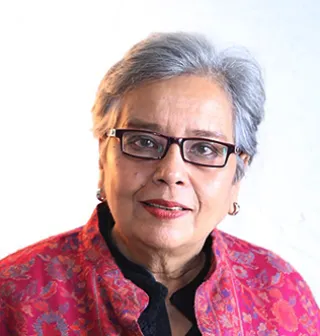-
CENTRES
Progammes & Centres
Location
Women have been dropping off from the labour force which is a poor indicator of a country’s progress no matter what the GDP growth indicates.

Image Source: PTI
Like most government outfits, the Niti Ayog seems to be obsessed with GDP growth to showcase India’s progress. In its Strategy for New India@75, it has forecast that India’s high growth path will continue and its GDP growth will touch 8 per cent in by 2022.
While GDP growth is a general growth indicator of a country, it hides many things. It is taken seriously by international rating agencies which influence foreign investors’ decisions. It glosses over problems relating to issues in gender relations. Niti Ayog’s paper has four pages on gender in its 205 pages’ report and that too almost at the fag end. It addresses some serious problems in a perfunctory manner, even though its recommendation for strengthening legal framework to eliminate discrimination against women is an important one.
A country with high GDP growth — but which has a problems of a wide gender gap, a large number of women committing suicides in the countryside in some of India’s prosperous southern states and the growing wage difference between men and women — cannot continue its development programmes for long. The serious social problems will affect GDP growth.
The government’s think tank should have taken heed of some of the grievous problems affecting women who comprise half the population and contribute 17 per cent to the GDP — which is less than half the global average. A country with high GDP growth — but which has a problems of a wide gender gap, a large number of women committing suicides in the countryside in some of India’s prosperous southern states and the growing wage difference between men and women — cannot continue its development programmes for long. The serious social problems will affect GDP growth.
India has been declared as the most dangerous country for women and yet it is one of the fastest economies in the world in terms of GDP. It is a distasteful label as it throws up the travails women are facing in urban and rural India today. With many foreign businesswomen travelling to India, this image will impact their impression and desire of doing business with India.
It is a fact that women get lower wages than men in most manual jobs in India. In agriculture, women earn a pittance which is one of the reasons for their low social status and lack of empowerment. In urban areas, women workers are again paid less than men. There is equal pay for women in government and some corporate jobs and there are also token women CEOs, especially in big private sector banks, who are earning huge amounts. According to the ILO, the wage gap in India is highest and women are paid 34 per cent less than men. Their real wage growth has been the lowest since 2008.
Gender equality is a crucial SDG goal, but India is far from achieving it. We have fared rather poorly in the latest World Economic Forum Gender equality report in which India ranked 108th out of 149 countries. It is measured against four pillars: economic opportunity, political empowerment, educational attainment, health and survival. India ranked 142nd out of 149 countries in economic opportunity and participation. It continued to rank third lowest in the world on health and survival. In this sub index, the gender gap has widened this year. India, however has improved wage equality for similar work indicator and it has closed its tertiary enrolment gap for the first time in 2018.
But do our politicians care? They are busy trying to win elections rather than improve the deep-rooted social problems. They often make false promises of introducing prohibition in order to woo women voters because drunken violence is a common cause for domestic discord. But it is lack of monetary income which is a source of weakness and vulnerability in women in villages. Women do mostly unpaid jobs around the house but cannot seek annulment of marriage or separation because they have no economic means of support.
Continued violence against women leads them to commit suicide. India accounts for 37 per cent of women’s suicides globally.
Patriarchy permits men to beat their wives at home and most women take this to be a natural phenomenon. Continued violence against women leads them to commit suicide. India accounts for 37 per cent of women’s suicides globally.
The Lancet Public Health Journal has reported that single, divorced and widowed women are less likely to commit suicide because marriage offers no protection against it. According to Lancet, arranged and early marriages and motherhood, low social status, and lack of economic independence also lead young women (between ages of 15 to 39) to commit suicide.
In many northern states, brides have to be brought from a different state as sex ratio is declining; there are no brides available for marriageable men locally. This is because sex determination is even now being practiced and women are getting abort female foetuses despite laws against such practices.
There is a gender bias in hiring. Even in educational institutions, there is patriarchy.
In urban India, it is not safe for women to walk after dark in some areas in big metro cities. Sexual harassment is again a deterrent for women to seek work in government offices and the corporate sector. Even in the largest companies, less than one tenth of the employees are women. Being forced to be home makers with rising household incomes, they are cut off from the outside world and get depressed, especially with abusive husbands and unable to stand up to continuous mental torture — women commit suicide.
Women have been dropping off from the labour force which is a poor indicator of a country’s progress no matter what the GDP growth indicates. According to Niti Ayog 23.7 per cent women are in the workforce which is a drop from 26.7 per cent in 2015-16. With greater participation of women in the labour force, it predicts that India’s GDP would rise by 1.4 per cent.
On the whole, despite high GDP growth, and despite efforts of different political regimes, no urgent effort is made towards making women more empowered, making sure that they work in safe and equal paying jobs. There is a gender bias in hiring. Even in educational institutions, there is patriarchy, particularly in engineering and technical colleges. Women entrepreneurs find it difficult to raise funds. They should be encouraged and given easier access to loans. Skill training has to be given to rural women to increase their capacity to earn incomes. Otherwise a lot of talent will be lost which could contribute to the economic growth of India and enhance the welfare of the people.
The views expressed above belong to the author(s). ORF research and analyses now available on Telegram! Click here to access our curated content — blogs, longforms and interviews.

Jayshree Sengupta was a Senior Fellow (Associate) with ORF's Economy and Growth Programme. Her work focuses on the Indian economy and development, regional cooperation related ...
Read More +
David Rusnok Researcher Strengthening National Climate Policy Implementation (SNAPFI) project DIW Germany
Read More +